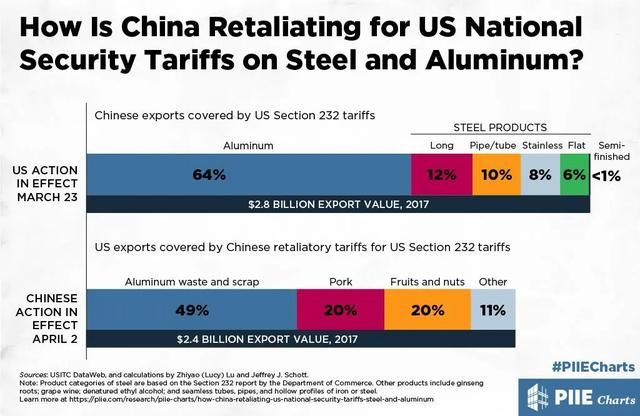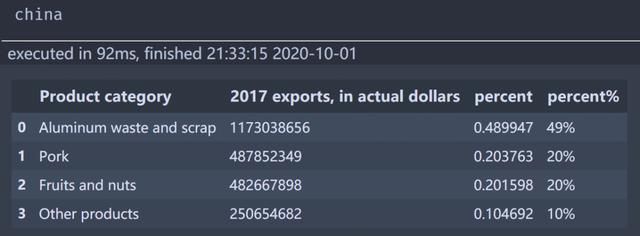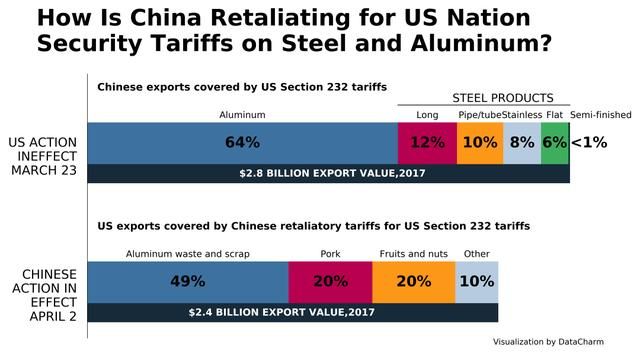Python-matplotlib数据可视化:商业图表条形图
本文的文字及图片来源于网络,仅供学习、交流使用,不具有任何商业用途,版权归原作者所有,如有问题请及时联系我们以作处理。
以下文章来源于DataCharm,作者 宁海涛
转载地址
https://www.zhihu.com/people/qi-shi-huan-hao-la-14/posts
绘制图标介绍
这篇推文是关于中美贸易的文章配图(具体我们这里我们不多做介绍,我们只关注配图的美观设计),文章的插图如下:
配图是真的没话说,特别是配色(这种配色我后面会做一个Excel的配图颜色系会比这个多几个色系。大家如果需求多,我会分享出来的哦)
Python matplotlib
绘图数据
这里的数据处理步骤暂且不过多介绍,绘图数据如下
可视化
我们直接上代码,大家不会的可以详细看代码中的注释:
china_color = ['#3D71A0','#B70050','#FD9717','#B6CBDF']
china_text = ['Aluminum waste and scrap','Pork','Fruits and nuts','Other']
us_color = ['#3D71A0','#B70050','#FD9717','#B6CBDF','#3DAE5E','#133831']
us_list = ['64%', '12%', '10%', '8%', '6%', '']
us_text = ['Aluminum','Long','Pipe/tube','Stainless','Flat',""]
barWidth = .6
lefts_china = 0
lefts_us = 0
fig,ax = plt.subplots(figsize=(8,4.5),dpi=200)
for bars, col,text,text2 in zip(china['2017 exports, in actual dollars'], china_color,china['percent%'],china_text):
ax.barh(1, bars, left=lefts_china, color=col, height=barWidth,align='center')
lefts_china += bars
#大家注意这里:可以详细看一下
if lefts_china == china['2017 exports, in actual dollars'][0]:
ax.text(bars/2,1,text,color="k",fontweight='extra bold',size=13,ha='center',va='center')
ax.text(bars/2,1.4,text2,color="k",fontweight='light',size=8,ha='center',va='center')
else:
ax.text(lefts_china-bars/2,1,text,color="k",fontweight='extra bold',size=13,ha='center',va='center')
ax.text(lefts_china-bars/2,1.4,text2,color="k",fontweight='light',size=8,ha='center',va='center')
#添加暗黑色柱形图
ax.barh(.6,china['2017 exports, in actual dollars'].sum(),color='#172A39',height=.35,zorder=0)
for bars, col,text,text2 in zip(us['2017 imports, in actual dollars2'], us_color,us_list,us_text):
ax.barh(3, bars, left=lefts_us, color=col, height=barWidth,align='center')
lefts_us += bars
if lefts_us == us['2017 imports, in actual dollars2'][0]:
ax.text(bars/2,3,text,color="k",fontweight='extra bold',size=13,ha='center',va='center')
ax.text(bars/2,3.4,text2,color="k",fontweight='light',size=8,ha='center',va='center')
else:
ax.text(lefts_us-bars/2,3,text,color="k",fontweight='extra bold',size=13,ha='center',va='center')
ax.text(lefts_us-bars/2,3.4,text2,color="k",fontweight='light',size=8,ha='center',va='center')
ax.barh(2.6,us['2017 imports, in actual dollars2'].sum(),color='#172A39',height=.35,zorder=0)
#定制化设置
ax.axis('off')
ax.axvline(x=0,ymin=.05,color='k',lw=.8)
ax.set_ylim(bottom=0,top=4)
#添加文本信息
ax.text(.02,.95,"Chinese exports covered by US Section 232 tariffs",
transform = ax.transAxes,color='k',ha='left',va='center',size=9,fontweight='semibold')
ax.text(.3,.64,"$2.8 BILLION EXPORT VALUE,2017",
transform = ax.transAxes,color='white',ha='left',va='center',size=8.5,fontweight='semibold')
#添加文本信息
ax.text(.02,.45,"US exports covered by Chinese retaliatory tariffs for US Section 232 tariffs",
transform = ax.transAxes,color='k',ha='left',va='center',size=9,fontweight='semibold')
ax.text(.2,.14,"$2.4 BILLION EXPORT VALUE,2017",
transform = ax.transAxes,color='white',ha='left',va='center',size=8.5,fontweight='semibold')
#再单独添加 semi-finished 描述部分
ax.text(us['2017 imports, in actual dollars2'].sum(),3,"<1%",ha='left',va='center',size=13,
fontweight='extra bold')
ax.text(us['2017 imports, in actual dollars2'].sum(),3.4,"Semi-finished",ha='left',va='center',size=8,
fontweight='light')
#添加小横线
ax.plot([us['2017 imports, in actual dollars2'][:1].sum(),us['2017 imports, in actual dollars2'].sum()],[3.55,3.55],
color='k',lw=.6)
text_loc = us['2017 imports, in actual dollars2'][:3].sum()
ax.text(text_loc,3.64,"STEEL PRODUCTS",ha='center',va='center')
#添加刻度文本
ax.text(-.02,.2,"CHINESE\nACTION IN\nEFFECT\nAPRIL 2",ha='right',va='center',fontweight='medium',size=11,
transform = ax.transAxes)
ax.text(-.02,.7,"US ACTION\nINEFFECT\nMARCH 23",ha='right',va='center',fontweight='medium',size=11,
transform = ax.transAxes)
#添加标题
ax.text(-.1,1.15,"How Is China Retaliating for US Nation\nSecurity Tariffs on Steel and Aluminum?",
transform = ax.transAxes,color='k',ha='left',va='center',size=20,fontweight='extra bold')
ax.text(.91,.05,'\nVisualization by DataCharm',transform = ax.transAxes,
ha='center', va='center',fontsize = 7,color='black')
plt.savefig(r'F:\DataCharm\商业艺术图表仿制\PIEE_Charts\China US\PIEE_china_us02.png',width=8,height=4,
dpi=900,bbox_inches='tight',facecolor='white')
#ax.set_axisbelow(True)
plt.show()
最终我们绘制的效果如下:
知识点
- 横向堆积柱形图绘制 这里举一个小栗子大家看下就可以:
from matplotlib import pyplot as plt
import numpy as np
N = 5
r = range(N)
bars1 = np.random.binomial(20, .7, N)
bars2 = np.random.binomial(20, .5, N)
bars3 = np.random.binomial(20, .4, N)
colors = ['#7f6d5f', '#557f2d', '#2d7f5e']
labels = ["Lasso", "Random Forest", "Decision Tree"]
barWidth = 1
lefts = 0
fig,ax = plt.subplots(figsize=(8,4.5),dpi=200)
for bars, col, label in zip([bars1, bars2, bars3], colors, labels):
plt.barh(r, bars, left=lefts, color=col, edgecolor='white', height=barWidth, label=label)
lefts += bars
plt.legend()
plt.ylim(-0.5, len(bars) - 0.5)
ax.text(.91,-.08,'\nVisualization by DataCharm',transform = ax.transAxes,
ha='center', va='center',fontsize = 7,color='black')
plt.savefig(r'F:\DataCharm\商业艺术图表仿制\PIEE_Charts\China US\PIEE_china_example.png',width=8,height=4,
dpi=900,bbox_inches='tight')
plt.show()
结果如下:
- 文本自动添加 虽然代码中有明确解释,但这里我们还是单独进行展示:
for bars, col,text,text2 in zip(us['2017 imports, in actual dollars2'], us_color,us_list,us_text):
ax.barh(3, bars, left=lefts_us, color=col, height=barWidth,align='center')
lefts_us += bars
if lefts_us == us['2017 imports, in actual dollars2'][0]:
ax.text(bars/2,3,text,color="k",fontweight='extra bold',size=13,ha='center',va='center')
ax.text(bars/2,3.4,text2,color="k",fontweight='light',size=8,ha='center',va='center')
else:
ax.text(lefts_us-bars/2,3,text,color="k",fontweight='extra bold',size=13,ha='center',va='center')
ax.text(lefts_us-bars/2,3.4,text2,color="k",fontweight='light',size=8,ha='center',va='center')
注意里面的if条件语句设置哦!






